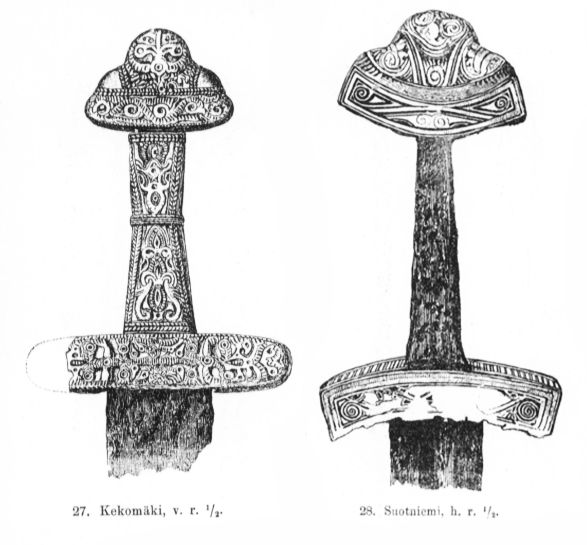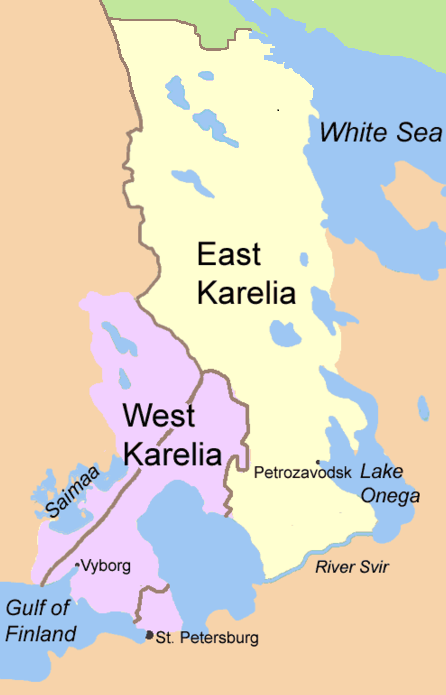|
Karelia (Finland)
Karelia (: ) is a historical province of Finland, consisting of the modern-day Finnish regions of South Karelia and North Karelia plus the historical regions of Ladoga Karelia and the Karelian Isthmus, which are now in Russia. Historical Karelia also extends to the regions of Kymenlaakso (east of the River Kymi), Northern Savonia ( Kaavi, Rautavaara and Säyneinen) and Southern Savonia (Mäntyharju). Karelia may also refer to the region as a whole, including the portion of Karelia within Russia. The term "Finnish Karelia" refers specifically to the historical Finnish province, while East Karelia or "Russian Karelia" refers to the portion of Karelia within Russia. Finland ceded a portion of Finnish Karelia to the Soviet Union after the Winter War of 1939–40. More than 400,000 evacuees from the ceded territories re-settled in various parts of Finland. Finnish Karelians include the present-day inhabitants of South Karelia and North Karelia, as well as the still-surviving e ... [...More Info...] [...Related Items...] OR: [Wikipedia] [Google] [Baidu] |
East Karelia
East Karelia (, ), also rendered as Eastern Karelia or Russian Karelia, is a name for the part of Karelia that is beyond the eastern border of Finland and since the Treaty of Stolbovo in 1617 has remained Eastern Orthodox and a part of Russia. It is separate from the western part of Karelia, called '' Finnish Karelia'' or historically ''Swedish Karelia'' (before 1808). Most of East Karelia has become part of the Republic of Karelia within the Russian Federation. It consists mainly of the old historical regions of Viena Karjala ( English: White Karelia) and Aunus Karjala ( English: Olonets Karelia). Culture and ideology 19th-century ethnic-nationalist Fennomans saw East Karelia as the ancient home of Finnic culture, "un-contaminated" by either Scandinavians or Slavs. In the sparsely populated East Karelian backwoods, mainly in White Karelia, Elias Lönnrot (1802–1884) collected the folk tales that ultimately would become Finland's national epic, the Kalevala (published ... [...More Info...] [...Related Items...] OR: [Wikipedia] [Google] [Baidu] |
Karelians
Karelians (; ; ; ) are a Baltic Finnic ethnic group who are indigenous to the historical region of Karelia, which is today split between Finland and Russia. Karelians living in Russian Karelia are considered a distinct ethnic group closely related to Finnish Karelians, who are considered a subset of Finns. This distinction historically arose from Karelia having been fought over and eventually split between Sweden and Novgorod, resulting in Karelians being under different cultural spheres. In Russia, Karelians mostly live in the Republic of Karelia, where they are the designated ethnic group, and in other adjacent north-western parts of the country. They traditionally speak the Karelian language and are Eastern Orthodox Christians. There are also significant Karelian enclaves in the Tver and Novgorod oblasts, as some Karelians migrated to those areas after the Russo-Swedish War of 1656–1658. In Finland, the term Karelian generally refers to the Finnish Karelians, who ... [...More Info...] [...Related Items...] OR: [Wikipedia] [Google] [Baidu] |
Stone Age
The Stone Age was a broad prehistory, prehistoric period during which Rock (geology), stone was widely used to make stone tools with an edge, a point, or a percussion surface. The period lasted for roughly 3.4 million years and ended between 4000 Anno Domini, BC and 2000 BC, with the advent of metalworking. It therefore represents nearly 99.3% of human history. Though some simple metalworking of malleable metals, particularly the use of Goldsmith, gold and Coppersmith, copper for purposes of ornamentation, was known in the Stone Age, it is the melting and smelting of copper that marks the end of the Stone Age. In Western Asia, this occurred by about 3000 BC, when bronze became widespread. The term Bronze Age is used to describe the period that followed the Stone Age, as well as to describe cultures that had developed techniques and technologies for working copper alloys (bronze: originally copper and arsenic, later copper and tin) into tools, supplanting ston ... [...More Info...] [...Related Items...] OR: [Wikipedia] [Google] [Baidu] |
Antrea Net
The Antrea Net is one of the oldest known fishing nets in the world, found in 1913 in the village of Korpilahti on the Karelian isthmus in Antrea, then in Finland but now belonging to Russia. It is dated to 8540 BCE. Discovery The net was found by farmer Antti Virolainen in Antrea, Finland (today Kamennogorsk, Russia) in autumn of 1913 at his home farm Ämmä-Mattila. While he was ditching a swamp meadow, he found several stone and bone objects which got his attention. Excavation The site was excavated by the Finnish archaeologist Sakari Pälsi in July 1914. In his excavation, Pälsi found 18 bobbers and 31 net weights and parts of the net. He also found several stone and bone objects, some birchbark and pieces of tinder fungus. All the items were found in a relatively small area, and they had likely come to the scene at the same time in one piece. The items were sunk to the bottom clay of the Ancylus Lake that existed during that period. Description The net is made out ... [...More Info...] [...Related Items...] OR: [Wikipedia] [Google] [Baidu] |
Mesolithic
The Mesolithic (Ancient Greek language, Greek: μέσος, ''mesos'' 'middle' + λίθος, ''lithos'' 'stone') or Middle Stone Age is the Old World archaeological period between the Upper Paleolithic and the Neolithic. The term Epipaleolithic is often used synonymously, especially for outside northern Europe, and for the corresponding period in Epipaleolithic Near East, the Levant and Epipaleolithic Caucasus, Caucasus. The Mesolithic has different time spans in different parts of Eurasia. It refers to the final period of hunter-gatherer cultures in Europe and the Middle East, between the end of the Last Glacial Maximum and the Neolithic Revolution. In Europe it spans roughly 15,000 to 5,000 Before Present, BP; in the Middle East (the Epipalaeolithic Near East) roughly 20,000 to 10,000 Before Present, BP. The term is less used of areas farther east, and not at all beyond Eurasia and North Africa. The type of culture associated with the Mesolithic varies between areas, b ... [...More Info...] [...Related Items...] OR: [Wikipedia] [Google] [Baidu] |
Karelian Iron Age Sword Hilts Schvindt 1893
Karelian refers to something from or related to the region of Karelia, in present-day Russia and Finland. * Karelians, an ethnic group in Russia speaking the Karelian language * Karelians (Finns), a subgroup of Finns * Karelian language Karelian (; ; ; ) is a Finnic language spoken mainly by the Karelians, Karelian people in the Russian Republic of Karelia. Linguistically, Karelian is closely related to the Finnish language, Finnish dialects spoken in eastern Finland, and some ..., a Baltic Finnic language * Karelian dialects, a group of Southeast Finnish dialects See also * Karelia (other) * Kurilian (other) {{disambig Language and nationality disambiguation pages ... [...More Info...] [...Related Items...] OR: [Wikipedia] [Google] [Baidu] |
Middle Ages
In the history of Europe, the Middle Ages or medieval period lasted approximately from the 5th to the late 15th centuries, similarly to the post-classical period of global history. It began with the fall of the Western Roman Empire and transitioned into the Renaissance and the Age of Discovery. The Middle Ages is the middle period of the three traditional divisions of Western history: classical antiquity, the medieval period, and the modern period. The medieval period is itself subdivided into the Early, High, and Late Middle Ages. Population decline, counterurbanisation, the collapse of centralised authority, invasions, and mass migrations of tribes, which had begun in late antiquity, continued into the Early Middle Ages. The large-scale movements of the Migration Period, including various Germanic peoples, formed new kingdoms in what remained of the Western Roman Empire. In the 7th century, North Africa and the Middle East—once part of the Byzantine Empire� ... [...More Info...] [...Related Items...] OR: [Wikipedia] [Google] [Baidu] |
Novgorod Republic
The Novgorod Republic () was a medieval state that existed from the 12th to 15th centuries in northern Russia, stretching from the Gulf of Finland in the west to the northern Ural Mountains in the east. Its capital was the city of Novgorod. The republic prospered as the easternmost trading post of the Hanseatic League, and its people were much influenced by the culture of the Byzantines, with the Novgorod school of icon painting producing many fine works. Novgorod won its independence in 1136 after the Novgorodians deposed their prince and the Novgorod ''veche'' began to elect and dismiss princes at its own will. The ''veche'' also elected the '' posadnik'', who was the chief executive of the city, and the archbishop of Novgorod, subject to approval by the Russian metropolitan. The '' tysyatsky'' was also elected by the ''veche'', who was originally the military commander, and served the interests of the common people. Novgorodian nobles known as boyars dominated the ''vech ... [...More Info...] [...Related Items...] OR: [Wikipedia] [Google] [Baidu] |
Western World
The Western world, also known as the West, primarily refers to various nations and state (polity), states in Western Europe, Northern America, and Australasia; with some debate as to whether those in Eastern Europe and Latin America also constitute the West. The Western world likewise is called the Occident () in contrast to the Eastern world known as the Orient (). Definitions of the "Western world" vary according to context and perspectives; the West is an evolving concept made up of cultural, political, and economic synergy among diverse groups of people, and not a rigid region with fixed borders and members. Some historians contend that a linear development of the West can be traced from Greco-Roman world, Ancient Greece and Rome, while others argue that such a projection constructs a false genealogy. A geographical concept of the West started to take shape in the 4th century CE when Constantine the Great, Constantine, the first Christian Roman emperor, divided the Roman Em ... [...More Info...] [...Related Items...] OR: [Wikipedia] [Google] [Baidu] |
Karelians (Finns)
Karelians (, ), also known as Finnish Karelians or Karelian Finns, are a subgroup () of the Finnish people, traditionally living in Finnish Karelia. Karelians speak eastern dialects of the Finnish language: the South Karelian dialects are spoken in South Karelia, while the eastern Savonian dialects are spoken in North Karelia. The South Karelian dialects were spoken in the Karelian Isthmus prior to the Winter War. Karelians are traditionally Lutheran Christians, with an Orthodox Christian minority, belonging to either the Evangelical Lutheran Church of Finland or the Orthodox Church of Finland respectively. Eastern Kymenlaakso belongs to the historical region of Finnish Karelia, as the Kymi River served as the boundary between the Tavastians and the Karelians during the Middle Ages. However, the Karelian presence in this region during the Middle Ages was weak, and migration from western Finland during this time resulted in an ethnic composition more closely resembling that o ... [...More Info...] [...Related Items...] OR: [Wikipedia] [Google] [Baidu] |
Evacuation Of Finnish Karelia
As a result of the 1940 Moscow Peace Treaty that concluded the Winter War, Finland ceded a portion of Finnish Karelia along with other territories to the Soviet Union. As a result, about 410,000 people, or 12% of Finland's population, were relocated to the remaining parts of Finland. The treaty did not require Finland to empty the ceded territory, but few were willing to stay, and almost the whole population chose to relocate, taking their belongings with them. Only the buildings and machinery were to be left behind intact as per the Peace Treaty, which for the most part also took place. During the Continuation War, some 260,000 of the displaced population returned home. In June 1944, Finnish troops partially withdrew from the ceded areas again as a result of the Soviet Fourth strategic offensive. Simultaneously, the population was again evacuated. The Paris Peace Treaty finally confirmed the loss of Finland's territory. The evacuees were permanently settled in Finland. The ... [...More Info...] [...Related Items...] OR: [Wikipedia] [Google] [Baidu] |






